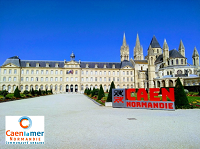Orateur
Description
One of the most exciting challenges in modern nuclear physics and astrophysics is to understand the behavior of nuclear matter under extreme conditions. Intermediate energy heavy-ion reactions provide a unique opportunity to enrich our knowledge about the nuclear equation of state (EoS) at sub-saturation densities [1,2]. In particular, the isospin transport in heavy-ion reactions at intermediate energies is directly correlated to the density dependence of the nuclear symmetry energy [3]. Recently, a Boltzmann-Uehling-Uhlenbeck equation based transport model of heavy ion reactions (BUU@VECC-McGill) [4,5] was upgraded by including a meta-modelling equation of state based on a density development around saturation [6], with parameters that can be tuned to reproduce ab-initio functionals from many-body perturbation theory. Based on this BUU@VECCMcGill transport model, isospin diffusion is studied for the 58,64Ni+58,64Ni reactions that are presently experimentally analyzed by INDRA-FAZIA collaboration at GANIL [7]. The comparison of isospin transport ratio from different isospin sensitive observables will be presented. The sensitivity of the isospin transport ratio on nuclear symmetry energy at saturation, its slope and curvature will be discussed. Finally, the dependence of isospin diffusion on the uncertainty still affecting the nuclear equation of states [8] will be described.
References:
[1] B.-A. Li and W.-U. Schroder, Isospin Physics in Heavy-Ion Collisions at Intermediate Energies (Nova Science, New York, 2001).
[2] S. Das Gupta, S. Mallik and G. Chaudhuri, Heavy Ion Reaction at Intermediate Energies: Theoretical Models (World Scientific Publishers, Singapore, 2019).
[3] M. B. Tsang et al., Phys. Rev. Lett. 92, 062701 (2004).
[4] G. F. Bertsch and S. Das Gupta, Phys. Rep. 160, 189 (1988).
[5] H.Wolter et.al, Prog. Part. Nucl. Phys. 125, 103962 (2022).
[6] S. Mallik, G. Chaudhuri and F. Gulminelli, Phys. Rev. C 100, 024611 (2019)
[7] C. Ciampi et al., Phys. Rev. C 106, 024603 (2022).
[8] S. Mallik, F. Gulminelli and D. Gruyer, Jour. Phys. G: Nucl. Part. Phys 49, 015102 (2021)

